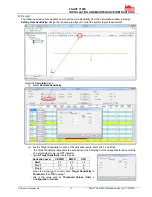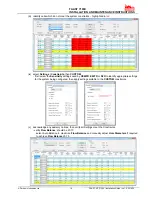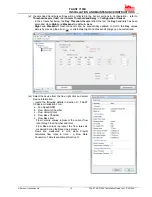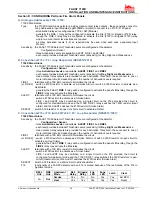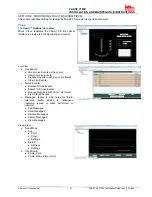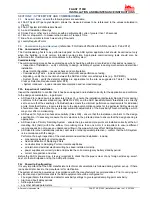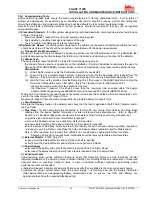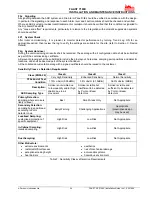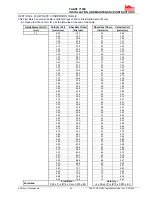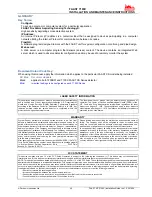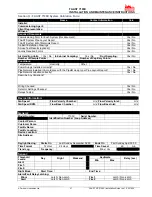
FAAST 7100X
INSTALLATION AND MAINTENANCE INSTRUCTIONS
© Pertronic Industries Ltd
23
FAAST XS (7100X) Installation Guide Iss 1.0, 201606
F2d. Commissioning
Tests
Before performing these tests ensure the area being protected is in its fully operational state – both in terms of
airflows and cleanliness. For example, any air handling units (AHUs) should be running, all floor and ceiling tiles
should be installed and any equipment producing a heat load should be in its normal operational mode.
Results from all tests, particularly details of the test positions, should be recorded so that they can be repeated
during Maintenance.
(i) Prescribed Standard :
for ASD systems designed to prescribed standards, commissioning tests should include
but are not limited to: -
• Maximum Smoke Transport Time from last sampling hole in system.
• Fault detection, including blockage and rupture of the pipe.
• Tests to confirm that Sampling Points are functioning.
(ii) Performance Based :
for ASD systems designed to a performance requirement additional performance tests
should be performed. They should be conducted in accordance with the design requirements.
a) Transport Time Measurement
Maximum Transport Time is measured by introducing smoke into the furthest Sample Point (or a dedicated test
point) and measuring the time between first introducing the smoke and observing a “reaction” at the detector.
b) Smoke Test:
The system Alarm response MUST be tested for functionality
using smoke
- the choice of smoke source is dependent on the
installation - Pertronic Industries recommends the use of a
Smoke Pen (PN: SMOKEPEN). Aerosol smoke is not recommended as it may leave residue inside the pipe
Stand-Alone:
(i) at the FAAST detector, verify the Particulate Level LEDs are all OFF
(ii) on each Pipe of a multiple branch system, introduce smoke into the Sampling Point furthest from the
detector – if the End Cap is configured as a Non-Sensing Point, use the penultimate Sampling Point
(iii) start the Timer as the smoke enters the Sampling Point, then move to the FAAST detector and stop the
Timer when Particulate Level 1 LED lights – this is the Transport Time for this Sample Point.
- the smoke must be present for the
duration of the test
- the Maximum Transport Time shall be less than the maximum time specified within the design
documentation/ engineering specifications but must not exceed 90 seconds (NZS4512:2010).
Where an Alarm indication is used it does not generally include any Alarm delays, which are temporarily set to
zero for the measurement of Transport Time.
Measured Transport Time should be compared to the predicted design Transport Time.
c) Fault Detection
Simulate the following faults on the detector and check that the fault is signalled at both FAAST detector
and at
the Fire Panel.
(i)
Pipe Flow :
for each sampling pipe connected to the FAAST unit, record Flow Velocity and Flow Base
readings from the device System Information for later reference during Maintenance – refer to Page 20,
Section (vii). Flow Base (BaseLine) should remain consistent, Flow Velocity should vary with each test
•
block the pipe and ensure a Low Flow Defect is reported
•
remove the Endcap and ensure a High Flow Defect is reported
•
block a single Sampling Point and confirm the Air-Flow indicator responds
•
block a series of Sampling Points and record the identity of each hole and number (quantity) required to
produce a Low Flow Defect – identifying the holes individually allows replication later for Maintenance
Note: A 20% reduction in volumetric flow (EN54-20) is considered an appropriate Defect condition.
Sampling Points do not usually block individually but all become contaminated at similar rates.
(ii)
External Monitor :
7100X Only (T6)
•
open-circuit the External Monitor and verify that a Fault is reported
•
short-circuit the External Monitor and verify the device performs a Reset
(iii)
Power Supply
:
•
disconnect the battery and verify that a fault is reported at the Fire Alarm Panel
•
disconnect the Mains supply and verify that a fault is reported at the Fire Alarm Panel
d) Functional Tests
Commissioning must include sufficient testing to verify that Sampling Points are fully functional. Careful
inspection/validation of the sampling holes to confirm that they are correctly drilled and comparison of measured
transport times to predicted transport times is often considered sufficient validation, particularly where
performance tests are specified.
•
identify and inspect a sample of Sampling Points and verify they are drilled to the correct size and spacing
•
measure the actual current drawn from the power supply – record this and use the Battery Calculator
(http://www.pertronic.co.nz/engineering/battery_calc/welcome.php) to ensure the PSU and Battery are
appropriate to achieve the required Standby period









